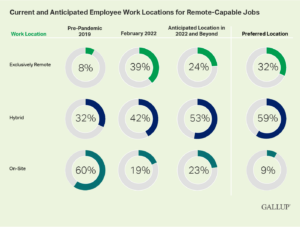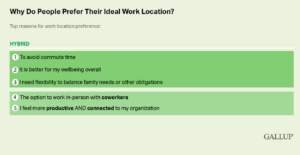These are the risks of forcing workers back to the office full-time, according to study
Only 9% of workers want to return to the office full-time, a Gallup study says. Employers must adapt.

Office work will never look the way it did in February 2020. That much is clear from a Gallup poll analysis on the future of hybrid work.
Gallup examined “the experiences, needs and future plans of more than 140,000 U.S. employees surveyed since the onset of the pandemic.” The biggest takeaway: Most employees don’t want to return to an office full-time. Some don’t want to return at all. In fact, a resounding 91% of employees don’t want to return to the office for 40 or more hours a week. Of those, 59% preferred remote work, while 32% wanted to be fully remote.
Just 9% told Gallup that they wanted to be in the office full-time again.
To be clear, this survey targeted workers who can complete their work from home at least part of the time, which Gallup says is about half the workforce, or 60 million Americans. Plenty of people still need to work on an assembly line, in a hospital or on a shop floor. Their needs are different.
Employers will face some difficult choices when deciding how to meet the needs of these these “remote-capable workers. And the risks of making the wrong decisions are high.
What do people value about a hybrid workplace?
Workers surveyed said that their biggest annoyance isn’t about being at the office at all. It’s about getting there.
Among employees who preferred a hybrid work schedule, the top reason cited was to avoid commute time. Again, these were employees who wanted to be in the office at least once in a while. But the daily grind of fighting traffic or waiting for the train just doesn’t appeal any more.
Other top reasons for choosing hybrid work included the belief that it is better for overall well-being and that the flexibility allows workers to balance personal needs with professional demands.
But not all the answers were about workers as individuals. The No. 4 reason cited was a desire to have the option to work in-person with coworkers, followed by the feeling of being more productive and connected to the organization.
Employers should look for ways to minimize commute time, maximize flexibility and place a priority on face-to-face interactions in the office.
What if employees can’t work the way they prefer?
The good news is that Gallup found that leaders and managers also prefer hybrid work. They understand the flexibility it offers (and likely enjoy it themselves). It’s the fully remote work arrangement that many see as a bridge too far. Gallup found that leaders and managers have concerns “about sustaining team performance and culture if team members work primarily from home, long-term.”
But there is danger here. Of those currently working from home full-time, 54% said they would look for other work if remote options were taken away; 38% of hybrid workers said the same.
Amid the Great Resignation, can any organization risk such high turnover rates?
Gallup found other consequences to removing remote-work options as well. If employees are forced to work fully onsite – and remember, 91% of workers prefer other options – they report feeling a significantly lower sense of well-being and engagement, along with significantly higher feelings of burnout and intent to leave.
What employers need to consider
There isn’t going to be a one-size-fits-all solution for the future of the workplace. Every organization – and in some cases every employee – will need to carefully consider their needs, their wants and where compromises can be reached.
But as the coronavirus finally loosens its hold on us, don’t expect to return to the Before Times. Employers should use the experiences of the past two years to chart a new course forward that strikes a balance between flexibility and cooperation.
As a communicator, you also must ensure that you’re explaining the why behind decisions. “Because that’s the way we’ve always done it” or “because that’s what the CEO wants” are answers of the past. Workers want real answers on what benefits both they, and the company, will receive from various work arrangements. Be transparent, clear and open about your answers.
Make sure to read Gallup’s full report for more insights into what workers want from a hybrid work environment.









